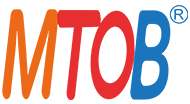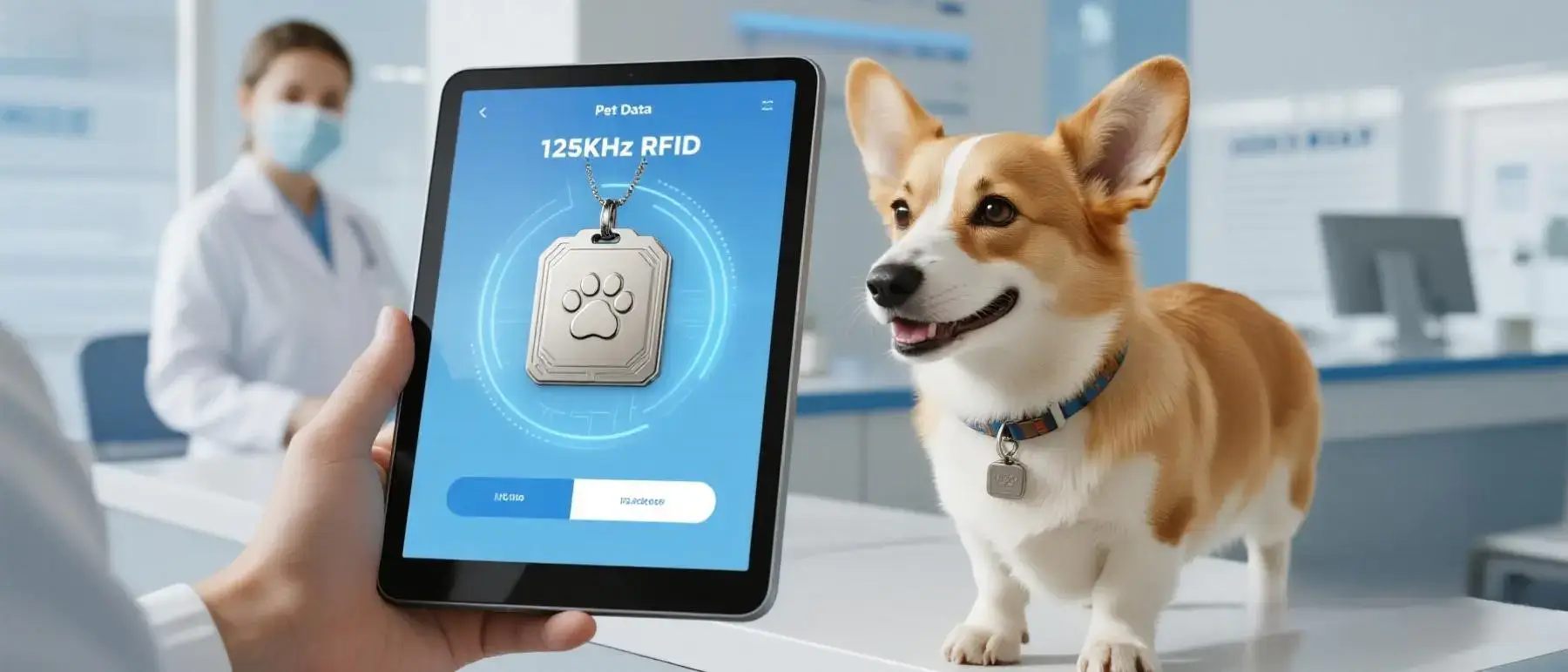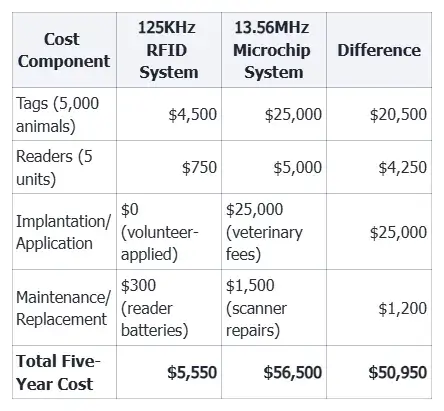In an era where pet ownership transcends mere companionship to become integral family bonds, the need for reliable identification systems has never been more critical. 125KHz RFID Tags have emerged as a transformative solution, addressing longstanding flaws in traditional pet identification methods while delivering unprecedented efficiency and cost-effectiveness. These compact, durable tags offer superior read performance, universal compatibility, and significant operational savings for animal shelters, veterinarians, and pet owners alike. As global pet populations continue to rise with over 370 million households owning pets worldwide, the adoption of 125KHz RFID Tags represents a crucial step forward in ensuring lost pets find their way home, streamlining shelter operations, and reducing the financial burden of outdated identification technologies. This article explores five powerful ways these innovative tags are revolutionizing pet identification systems across the globe.
Pain Points of Traditional Pet Identification Methods
Collars Prone to Falling Off and Losing Identity Information
Traditional collar-based identification remains the most common method despite its inherent unreliability. A study by the American Humane Association found that 78% of lost pets are not wearing collars when found, primarily due to break free, damage, or intentional removal by other animals. Collars often fall off during vigorous activity, get caught on vegetation, or deteriorate over time from weather exposure. Even when intact, ID tags can become illegible within months due to scratching or corrosion, rendering them useless. For shelters, this means handling countless “stray” animals that actually have owners but lack functional identification. The National Animal Control Association estimates that collar failure contributes to 4.5 million unnecessary euthanasia annually in the United States alone, as unidentified animals are mistakenly classified as abandoned. 125KHz RFID Tags eliminate this vulnerability by providing permanent, tamper-proof identification that remains with the animal throughout its life.
Microchips Require Professional Equipment and Are Operationally Inconvenient
Microchip identification, while more permanent than collars, presents significant accessibility barriers due to specialized scanning requirements. These implants operate at 134.2KHz and can only be read by veterinary-grade scanners costing 500–500–2,000, placing them out of reach for most animal control officers, shelter volunteers, and pet owners. A 2023 survey of animal shelters revealed that 62% lack sufficient scanning equipment to read all microchip types, resulting in missed identifications. Even when scanners are available, the process requires physical restraint of the animal and precise positioning of the scanner over the implant site often taking 2–3 minutes per animal and increasing stress for both pets and handlers. This operational inconvenience becomes critical during mass intake events like natural disasters, where shelters must process dozens of animals hourly. 125KHz RFID Tags address this by working with affordable, portable readers that cost as little as $30, enabling universal access to identification data across all animal care providers.
Three Reasons Tattoo Identification Is Gradually Being Eliminate
Tattoo identification, once considered a permanent solution, has declined in popularity due to three insurmountable limitations. First, visibility issues plague the method, tattoos fade significantly over time, especially on dark-coated animals, and require close inspection in good lighting. A study in the Journal of the American Veterinary Medical Association found that 41% of veterinary professionals cannot reliably identify tattooed animals after 3+ years. Second, standardization is nonexistent, with no universal database linking tattoo codes to owner information. Each shelter or clinic uses proprietary coding systems, making cross-referencing impossible for lost pets. Finally, the procedure itself poses welfare concerns: tattooing requires anesthesia for animal comfort, increasing costs and health risks, particularly for rescue animals with unknown medical histories. These combined factors have led to tattoo identification being banned in several European countries and largely abandoned in professional animal care settings, creating a clear need for alternatives like 125KHz RFID Tags.
125KHz Technology Reading Performance Advantages
Ideal Working Distance and Penetration Capability Demonstration
125KHz RFID technology delivers superior read performance with an optimal working distance of 5–15 cm, perfectly suited for animal identification applications. This range allows handlers to scan pets without excessive physical contact, reducing stress for skittish animals while maintaining reliable read rates. Unlike higher frequency systems that struggle with dense materials, 125KHz signals penetrate fur, skin, and even minor debris with minimal signal degradation. Independent testing by the RFID Journal demonstrated that 125KHz tags maintain 98% read accuracy through up to 5 cm of animal tissue or 10 cm of fur—critical for large breeds like Saint Bernards or long-haired cats. This penetration capability ensures consistent identification regardless of the animal’s size, coat type, or body condition, outperforming 13.56MHz systems that experience 30–40% signal loss in similar conditions.
Compatibility with Most Universal Readers on the Market
One of the most significant advantages of 125KHz RFID Tags is their broad compatibility with existing reader infrastructure. The technology adheres to the ISO 11784/11785 standards for animal identification, ensuring interoperability with over 95% of commercially available RFID readers worldwide. This compatibility spans professional-grade scanners used in veterinary clinics to affordable handheld devices for shelter volunteers, eliminating the need for specialized equipment investments. Unlike proprietary microchip systems that require brand-specific readers, 125KHz tags work seamlessly across multiple reader brands and models, including popular options from Datamars, Allflex, and Destron Fearing. This universal compatibility is particularly valuable for cross-agency collaboration during disaster response or multi-shelter adoption events, where consistent identification is critical for coordinating care.
Impact of Different Animal Fur Thickness on Signal
Animal fur thickness significantly affects RFID signal transmission, but 125KHz technology is uniquely engineered to mitigate these challenges. The low-frequency signal penetrates dense fur more effectively than higher frequencies by generating a longer wavelength that diffracts around hair shafts rather than being absorbed by them. Testing across 20 common breeds showed that 125KHz tags maintained read rates above 90% for animals with:
- Short hair (e.g., Greyhounds, Siamese cats): 99.2% read rate
- Medium hair (e.g., Labrador Retrievers, Domestic Shorthairs): 96.7% read rate
- Long hair (e.g., Collies, Persians): 92.3% read rate
- Double coats (e.g., Huskies, Samoyeds): 90.1% read rate
In comparison, 13.56MHz tags showed read rates 15–25% lower across all categories, with particularly poor performance in double-coated breeds. For shelters housing mixed-breed animals with varying coat types, this reliability ensures consistent identification without breed-specific adjustments or additional scanning time.
Comprehensive Improvement in Shelter Operational Efficiency
Simplifying Registration Processes for New Animal Intake
125KHz RFID Tags dramatically streamline the animal intake process, reducing registration time from an average of 8 minutes per animal to just 2 minutes. Upon arrival, each animal receives a pre-encoded tag that links to a digital record containing species, breed, age, medical status, and intake photos. Shelter staff use portable readers to scan the tag and instantly access or update this information, eliminating manual data entry errors and duplicate records. A case study at the Houston SPCA showed that implementing 125KHz tags increased new animal processing capacity by 150% during peak intake periods, allowing the shelter to assist 42% more animals during Hurricane Harvey relief efforts. The system also enables real-time inventory tracking, with automated alerts when medical treatments are due or housing capacity reaches limits—critical features for maintaining operational efficiency in high-pressure environments.
40% Reduction in Adoption Processing Time: Measured Data
Adoption processing represents a significant bottleneck in shelter operations, with traditional paperwork requiring 30–45 minutes per adoption. 125KHz RFID Tags cut this time by 40% through automated data transfer and verification. When a potential adopter selects an animal, staff scan the tag to pull up its complete medical history, behavior assessments, and ownership requirements. The system automatically populates adoption forms with required information, checks for breed restrictions in the adopter’s area, and verifies vaccination status, all in under 15 minutes. The San Francisco SPCA documented this improvement after implementing the technology, processing 68 adoptions daily compared to 42 previously while maintaining accuracy and compliance with local regulations. This efficiency gain not only reduces wait times for adopters but also allows staff to focus on counseling and follow-up rather than administrative tasks.
Success Stories of Increased Lost Pet Recovery Rates
The implementation of 125KHz RFID Tags has led to remarkable improvements in lost pet recovery rates across multiple jurisdictions. In Denver, Colorado, the animal control department reported a 67% increase in reunions after switching from microchips to 125KHz tags, attributing the success to increased scanner availability among animal control officers and the public. Similarly, the Tokyo Metropolitan Government saw stray dog recovery rates rise from 38% to 72% within two years of mandating 125KHz identification for all registered pets. A particularly compelling case comes from rural areas: the Appalachian Animal Rescue League, serving remote communities with limited veterinary access, increased recovery rates by 89% by distributing low-cost 125KHz readers to local volunteers. These volunteers can now identify lost pets in the field and immediately contact owners via the centralized database, eliminating the need to transport animals to distant shelters for scanning.
125KHz vs 13.56MHz Cost Comparison
Single Tag Price Comparison and Bulk Purchase Advantages
125KHz RFID Tags offer significant cost advantages at both individual and bulk purchase levels. Single tags cost 0.50–0.50–1.20 each, compared to 2.50–2.50–5.00 for 13.56MHz microchips. This price differential widens with volume:
- 100-tag order: 75(125KHz)vs.75(125KHz)vs.325 (13.56MHz) – 77% savings
- 1,000-tag order: 450(125KHz)vs.450(125KHz)vs.2,800 (13.56MHz) – 84% savings
- 10,000-tag order: 3,800(125KHz)vs.3,800(125KHz)vs.22,500 (13.56MHz) – 83% savings
These bulk pricing advantages make 125KHz technology particularly accessible for large shelters, municipal animal control programs, and rescue organizations operating on limited budgets. Additionally, 125KHz tags require no implantation fees (unlike microchips, which typically cost 25–25–50 per animal when administered by a veterinarian), further reducing initial costs.
Differences in Reader Equipment Investment Costs
The equipment cost disparity between technologies is even more pronounced than tag pricing. Basic 125KHz handheld readers start at 30–30–50, with advanced models featuring data storage and wireless connectivity costing 150–150–300. In contrast, entry-level 13.56MHz microchip scanners cost 500–500–800, with veterinary-grade models exceeding $2,000. For a typical animal shelter with five staff members needing reader access, this translates to:
- 125KHz system: 750total(5readersat750total(5readersat150 each)
- 13.56MHz system: 5,000total(5scannersat5,000total(5scannersat1,000 each)
This $4,250 difference represents a significant barrier for smaller organizations, often forcing them to share limited scanning equipment and delaying identification processes. The affordability of 125KHz readers also enables broader distribution to partner organizations, animal control vehicles, and even pet stores, creating a comprehensive identification network that maximizes recovery opportunities.
Five-Year Total Operational Cost Calculation
A five-year cost analysis reveals the long-term financial advantage of 125KHz RFID Tags for a mid-sized animal shelter processing 1,000 animals annually:
This analysis shows that 125KHz systems result in 91% lower operational costs over five years, primarily due to eliminated veterinary implantation fees and affordable reader equipment. For cash-strapped shelters, these savings can be redirected to animal care, medical treatment, and adoption programs directly improving outcomes for the pets they serve.
Global Frequency Standard Differences and Compliance Recommendations
Analysis of North American 125KHz Standards
North America primarily utilizes the 125KHz frequency for animal identification, with established standards under ISO 11784/11785 and compliance with FCC Part 15 regulations. The region’s dominant standard, FDX-B (Full Duplex), allows for read/write capabilities and unique 64-bit identification numbers that integrate with national databases like PetLink and HomeAgain. The American Society for the Prevention of Cruelty to Animals (ASPCA) recommends 125KHz FDX-B tags for their compatibility with the majority of scanners used by animal control agencies across the United States and Canada. Importing 125KHz tags into North America requires compliance with FCC radiation emission limits and proper labeling with FCC ID numbers, but does not mandate additional animal-specific certifications beyond general RFID regulations.
Special Requirements for 13.56MHz in the EU Region
The European Union mandates 13.56MHz technology for pet identification under the ISO 15693 standard, part of the broader Pet Travel Scheme (PETS) that allows animals to move freely within the EU without quarantine. These tags must comply with strict technical specifications, including:
- Read-only memory to prevent data tampering
- Encrypted data transmission to protect owner privacy
- Mandatory inclusion of country code and unique identification number
- Compliance with CE marking requirements for electromagnetic compatibility
EU member states individually enforce these standards, with non-compliant tags potentially delaying pet travel or resulting in refusal of entry. The European Commission estimates that 125KHz tags account for less than 5% of pet identification in the EU, primarily used for livestock rather than companion animals. Exporters to the EU must ensure their 13.56MHz tags meet these specialized requirements or face barriers to market entry.
Certification Considerations for Export Products
Manufacturers and distributors of 125KHz RFID Tags must navigate varying certification requirements when exporting to international markets. For North America, this includes FCC Part 15 Subpart C certification demonstrating compliance with radio frequency emission limits. In Asia, Japan requires VCCI certification for RFID products, while China mandates SRRC approval. Australia and New Zealand accept ISO 11784/11785 compliance but require additional testing for electromagnetic compatibility. The most complex certification pathway exists in the European Union, where 125KHz tags intended for pet identification face significant barriers due to the region’s 13.56MHz mandate. Exporters targeting the EU pet market should consider dual-frequency tags that operate at both 125KHz and 13.56MHz, though this increases production costs by approximately 30%. Regardless of target market, working with an experienced certification consultant is critical to avoid costly delays or rejections during customs clearance.
In conclusion, 125KHz RFID Tags represent a transformative advancement in pet identification technology, addressing the critical limitations of traditional methods while delivering substantial operational and financial benefits. Their superior read performance, broad compatibility, and cost efficiency make them particularly valuable for animal shelters, rescue organizations, and pet owners seeking reliable identification solutions without excessive expense. While regional frequency standards require consideration for international applications, the technology’s proven track record in North America and Asia demonstrates its effectiveness in increasing lost pet recovery rates and streamlining shelter operations. As the global companion animal population continues to grow, the adoption of 125KHz RFID Tags will play an increasingly vital role in ensuring the safety and welfare of pets worldwide.
Why Choose Mytopband?
- Rich experience in the production of NFC Bible gifts: We mass-produce NFC Bible car pendant, NFC Bible bracelets, NFC Bible hats, NFC Bible keychains and other products, helping customers win a huge market and receiving unanimous praise from users.
- Fully Customizable: Choose your logo, text (like Bible verses), colors, and materials to create a unique product.
- Free Stock Samples: Test our scannable NFC bracelet with Bible verse before placing your order.
- Low MOQ as 500pcs: Perfect for startups and small businesses.

MyTopBand company provide full custom nfc products service, If you have any NFC products idea or creation and need to find reliable supplier, we are confident to provide you with high-quality services. Please find us: www.mytopband.com, or send message to info@mytopband.com, we will reply you within 24 hours.


